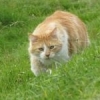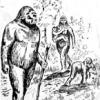In reference to Norseman's comments: One of the techniques I often use when taking people up the hill is to show them a deer track. Doe, buck, yearling? But most importantly, if we are not in snow, I ask them to show me the other three tracks that match the one observed. And, after that, to show me not the next set of tracks made by the four hooves, but the third set in succession. It is rare that a new observer can make it that far along a track line.
I'm just mentioning this in regards to the discussion of track rarity and repetitiveness in regards to hooved animals. With luck we'll find a bear track.
In our area of interest, depending on the population cycle, in the Cascades there is about one bear per two square miles during population peaks and one bear per four - five square miles at the bottom of the cycle. So, the idea is to tell people that bears are fairly common and that we should "easily" find a track in three-four hours of wandering. Often, if there is no snow, no bear track is found, mainly because new people don't go near water much, they like to stay "up high" where they can see things and not fight brush.
Then, the exercise in finding succeeding bear tracks in the track line proves much more difficult than with hooved animals. Now, let me go "wild" and estimate one Bigfoot per 10-20 square miles depending on habitat. How many track finds and how often? I feel successful if I'm up 20 plus days a year, spend a lot of time afoot and find one unmistakable Bigfoot track. Two or three in a line is a very rare treat. So, I'm just saying that a "researcher" must persevere and not go up the hill to find Bigfoot tracks. You better have something else on your alleged mind.
When I had the film crew from Missouri up for several days and they stumbled on their first track -- which was obviously left as a marker of some kind -- they were astounded. It was in mud beside a creek next to a game trail crossing. I was over a little ridge so by the time I got there the fellow carrying their "black" box had slipped and ruined it, but fortunately they had photographed it. Well, enough rambling for now except for one more "thing."
The story behind the photo: Managed to stay dry that night with only a tarp, but I was alone so that made it easier. This point is about 15 miles {no exaggeration} from the nearest often used road, and by often, since I often camp near it, I mean 1 truck per hour per summer day, maybe 1-2 during the night. That night, after the rain, one came around and walked around camp leaving several tracks. So the moral of the story is to go to where they are and let them come to you.



